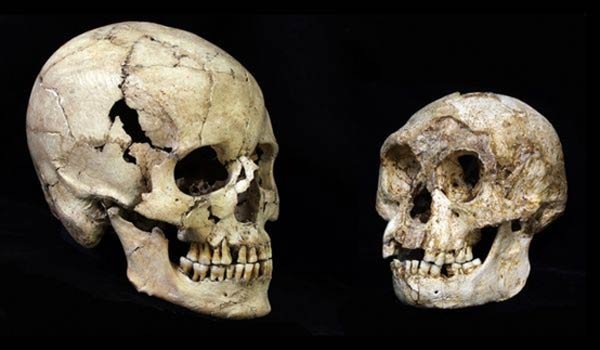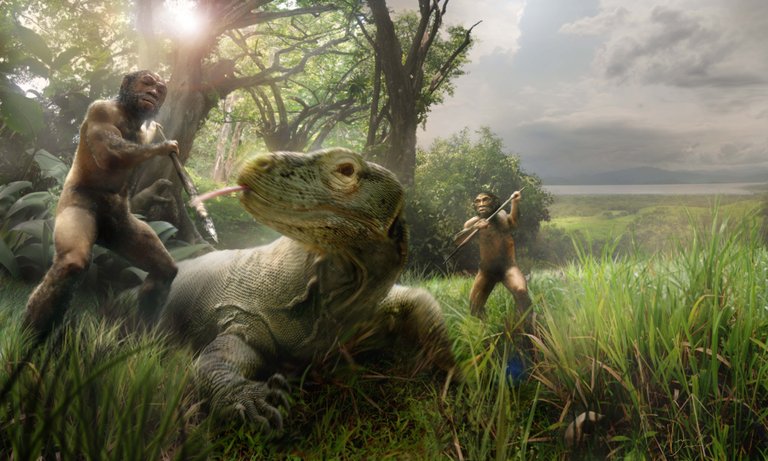The Hobbits of Flores:
Note: There remains heavy debate within the relevant social sciences as to whether Homo Floresiensis really existed. This post looks at HF from the perspective that it existed as a separate and distinct species of the genus homo.
The skeletal remains of dwarf like hominids, in a cave on the island of Flores, raised many questions alongside their discovery. For the most part, social scientists wonder where this hominid originates from.

To date, this is the smallest hominid to have been discovered. The skeletal remains found in the cave indicate that Homo Floresiensis (HF) was not much taller than 1m (or 3 foot). It was thus aptly named 'the Hobbit of Flores'. Dating techniques have indicated that HF lived between 100,000 to 50,000 years. The fascinating part about this is that, at some point in time, they inhabited the island whilst modern humans walked the earth.
Alongside the discovery of Homo Floresiensis was the emergence of an argument that stated that Homo Floresiensis was a smaller version of modern homosapiens. Scientists argued that Homo Floresiensis was a normal human afflicted by a pathology. This specific pathology (microcephaly) would have affected anatomical size. Modern research, however, proves That Homo Floresiensis is a unique species in the genus homo. Consequently, Homo Floresiensis is more similar to early humans and other apes than it is to modern humans.
The most obvious identifying anatomical features of Homo Floresiensis is its small body and skull. The small skull reveals that Homo Floresiensis had a small cranial capacity. Its brain was slightly smaller than that of a chimpanzee.
Despite HF’s small brain, advanced behaviours have been associated with the hominid. The archaeological site shows evidence of the use of fire for cooking. Remains from pygmy elephants (stegodon) litter the cave and exhibit cut marks - evidence of the use of tools. Impressively enough, stone tools resembling that of the lower paleolithic tools found in Asia and Oldowan tools found in Africa emerged with the excavations.
The tools that HF left behind could potentially indicate cognitive superiority to what scientists would expect from their small brains. These tools indicate some form(s) of cooperative hunting. Their prey, which included the pygmy-elephants, were much larger than them. Hunting was dangerous and the need for coordination and communication (albeit very primitive) is almost a given. The island was also inhabited by big Komodo dragons.
It is difficult to identify the exact reasons behind HF's size. Scientists hypothesize that Evolution nudged HF to adapt to its island environment. A lack of nutrition and no real threat from predators meant HF became smaller. Survival necessitated eating less (a closed of environmental system had limited food) which meant burning less calories. Less food meant less caloric expenditure which led HF becoming smaller. The fact that they had no natural threats meant that size wasn’t necessary for survival, either. In terms of survival, the Island of Flores favoured small mammals. Animals have already shown that sometimes shrinking is necessary for the purposes of survival (pygmy elephant, buffalo and hippopotamus).
It is still unclear how Homo Floresiensis relate to other species in the genus homo. Scientists are still fitting the pieces together. Whether their lineage will be traced back to homo erectus or another species, remains unclear. The discovery of Homo Floresiensis proves, though, that genes are intricately unpredictable.
On a side note, inhabitants of the islands speak about "Ebu Gogo": little people that cause mischief. They are intertwined with the local's folk-stories and are eerily similar to the information available on Homo Floresiensis. Food for thought.
Sources:
Balzeau, Antoine; Charlier, Philippe (2016). "What do cranial bones of LB1 tell us about Homo floresiensis?". Journal of Human Evolution. 93: 12–24.
Huize, M (2014). Expedition to Flores-island. mjhuize.blogspot.co.za/2014/04/expedition-to-flores-island.html; accessed: 20 February 2008.
Martin, R. D.; MacLarnon, A. M.; Phillips, J. L.; Dussubieux, L.; Williams, P. R.; Dobyns, W. B. (19 May 2006). "Comment on "The Brain of LB1, Homo floresiensis"". Science. 312 (5776): 999
Morwood, M. J.; et al. (13 October 2005). "Further evidence for small-bodied hominins from the Late Pleistocene of Flores, Indonesia". Nature. 437 (7061): 1012–1017



